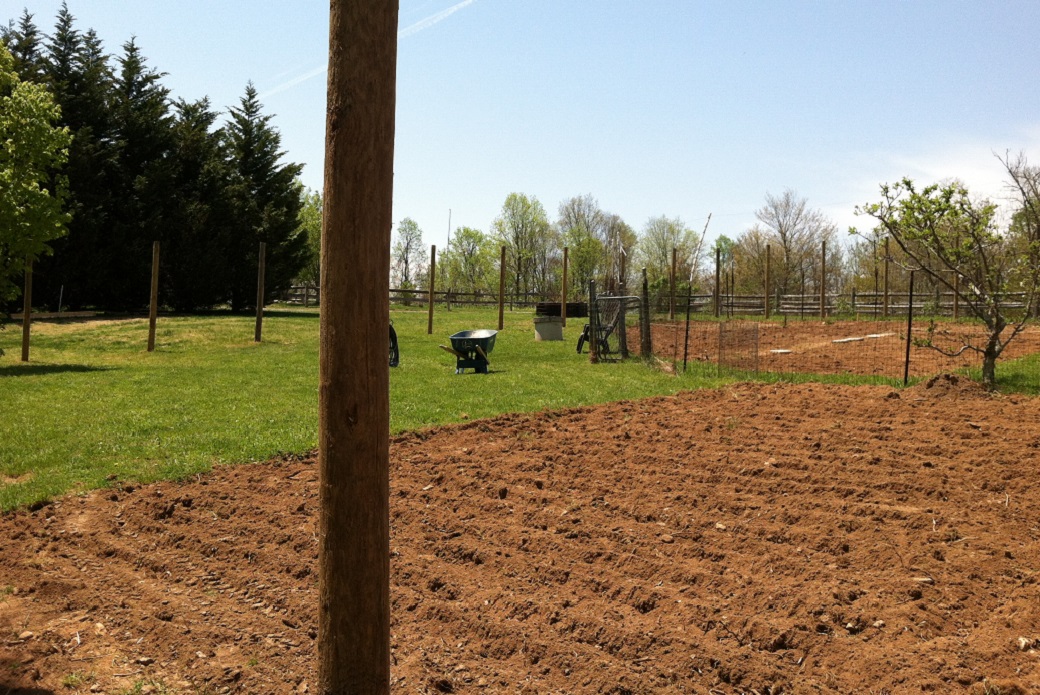If you are one of the many people who have a home with a lawn, but know something wicked this way comes, you may have said to yourself, "I have plenty of room in the yard, so I can grow my own food if I need to." I have heard this from a number of people lately.
Should this be your ‘Plan B’ for extreme food inflation or shortages, you might want to get a jump start on the work involved because it is not easy and involves a number of factors you may not have considered. I know because we are currently undertaking just such a task.
After moving to our new mountain homestead last summer we bought a large rear tine gas powered garden tiller to turn the earth. Once we decided on the size and brand, Amazon prime quickly shipped it. How much longer we can expect quasi-affordable prices and prompt and inexpensive delivery service for major power equipment in this day and age is anyone's guess, so you should seriously consider purchasing this or similar power equipment now.
The small garden bed area we turned and planted the prior year was put right to work this year. But before anything was actually planted the process began with mental plans and rough sketches of what we wanted to do with this year's planting. This year we decided to greatly expand the garden area by a factor of four or more. The problem was that most of the increase is, or was, lawn; a combination of grass and weeds mowed just like the rest of the yard.
Do not assume you have decent soil any deeper than a few inches below the surface of the grass, particularly if your home was built in the last twenty years or so. Most building contractors truck in just enough top soil to lay down a layer of sod or spread some grass seed. Often the soil beneath is of poor quality, filled with rocks and clay or even building debris. You might want to dig some test holes now or be severely disappointed later.
And while you are thinking about soil conditions you might want to consider where you will source the water you will need for your garden, particularly if you live in an area of the country with low rainfall. If you currently have a well, find out when it was dug or drilled, what is its flow and recovery rate and if your neighbors nearby with gardens already in production have problems with their wells.
If you are on city/municipal water you must assume that as inflation rages and water shortages develop your water supply will become very expensive and the quality will plummet. Plus your garden will not like the chlorine and other chemicals regularly added to city water. Scout around for a second and third source of water.
When considering the area you wish to garden, it is essential to identify the predators likely to get in and how you can prevent their entry. One night of furry frolic in your garden can wipe out a season of effort, and the right fence can go a long way to stopping their access. Deer can fly, bears will do anything to get to fruit, and bunnies are both hungry and tend to vandalize for the pure pleasure of it. Moles and groundhogs can easily tunnel under minimal fence barriers. What creatures might you need to protect your garden from and what type of fencing will accomplish this? What supplies will you need, what are the costs and who has the knowledge and time to install it?
 After we had carefully considered, compromised over and then completed the planning of our fence, I sent the hubby out into the garden prior to the last frost to turn the new growing areas……twice. The hubby is a big strong guy and still this was slow, hard work requiring back rubs and Ben-Gay after each turning. Because this lawn area had never been turned before, the soil was hard packed and full of rocks. It is clear that an inexpensive tiller, something normally used for weed control and turning already loose soil, will bog down and even break under the stress of digging into virgin soil covered in lawn. A self propelled counter rotating rear tine tiller is the way to go if it is within your budget. We decided to buy our fence from Oakdale Fencing and we love it! It works brilliantly.
After we had carefully considered, compromised over and then completed the planning of our fence, I sent the hubby out into the garden prior to the last frost to turn the new growing areas……twice. The hubby is a big strong guy and still this was slow, hard work requiring back rubs and Ben-Gay after each turning. Because this lawn area had never been turned before, the soil was hard packed and full of rocks. It is clear that an inexpensive tiller, something normally used for weed control and turning already loose soil, will bog down and even break under the stress of digging into virgin soil covered in lawn. A self propelled counter rotating rear tine tiller is the way to go if it is within your budget. We decided to buy our fence from Oakdale Fencing and we love it! It works brilliantly.
Before doing any planting I first set about testing the soil. Inexpensive testing kits that read the pH levels as well as N, P, and K (nitrogen, phosphorus and potassium) are sold at most garden and farm stores. My research informed me that it was important to test several different locations throughout the garden as results can, and will, vary dramatically depending upon a number of factors, including what had been grown there before. Just because your garden was previously a lawn does not mean the soil is uniform in pH and nutrients.
After learning about your soil, in order to know what additional components are needed to balance the soil, you must know what you will be growing, and where, because different crops require different soil conditions to abundantly produce. In order to determine this, a preliminary plan of the garden must be developed.
This means carefully considering what to grow. I would like my family to be able to consume the fruits of our labors. What ingredients did I want us to eat fresh from the garden as opposed to preserved and eaten later? For that matter, what did I know how to preserve/can and what was I willing to learn? Were there particular items that were important for me to grow and replace from our normal weekly grocery purchases? I went through my notes and folder from last year and made extensive lists. Most important of all, what was my family willing to eat more than once or twice a month.
When a garden begins to really produce, what you don’t preserve/can must either be eaten, given away or thrown out/composted. Squash twice a month is nice, squash five times a week is another matter entirely. Some trial and errors are inevitable, but resist the urge to plant large volumes just because it sounds like it would be good to eat, unless it can be preserved. Variety is as important than volume if you wish to sustain your family’s interest in what comes out of the garden beyond the first harvest.
Back in the office I sketched out a map of the garden, complete with surrounding trees and sheds, and made several copies of the basic layout to experiment with the planting plan. On one copy I made notes of which areas received sunlight and for how long during the day. The hubby was clever enough to point out that these times and angles of the sun change throughout the year. The amount of sun and shade at the beginning and end of the growing season can be quite different from the middle of the summer. If your former lawn has trees and/or buildings surrounding the garden area, this could seriously curtail your garden production and growing season. It might be worthwhile to check out something like this Best Chainsaw to help you get rid of the trees if you need more space. You might be fine leaving the trees where they are, but if you want, cutting them down will help open up your garden more and improve your garden productivity. If you don't want to sort your trees out yourself you could take a look at using a professional tree service company to do all the hard work for you. If this is something that interests you then you could take a look at something like Treequote.com to give you a better idea of the services that these professionals provide.
Next I took another copy of my garden sketch and recorded where (and when, if the growing season is long enough to harvest two crop rotations in one season) I grew various beds of plants and flowers last year. I repeatedly read that rotating the crops each year is perhaps the single most important consideration in vegetable gardening. Certain plant families drain, or sometimes add, nutrients and minerals to the soil, which in turn often requires a different growing location each year.
Also, the pests and other insect problems unique to a particular plant family, like squash, will remain in the soil and attack the plant again the following year unless relocated. Knowing where you planted last year, and where you might rotate the crop to next year, is essential in deciding where to place this year's seeds and transplants now. In essence each year you are planning two gardens, one for this year and one for the next.
Just prior to the last of the spring frosts I shopped the local greenhouses and garden centers to find out which heirloom varieties of seedlings and starter plants they would carry. I also ordered the seeds I wanted for many other varieties. While in the garden centers I discovered several other items to grow that had not been on my initial planning list, including many herbs and flowering plants that can be used to add some variety and spice to the harvest.
Finally, after gathering supplies to boost the nutrients in the soil, choosing the plants and herbs I wanted to grow and planning where to put them, then acquiring the plants and seeds themselves, I was rocked to discover that the real work had just begun. Even after turning the lawn area twice, many clumps of green grass with attendant roots still lived (and grew) near the surface, in addition to various sized rocks, all of which needed to be removed and hauled away.
 Block by block, row by row, I turned the dirt by hand, now relatively fluffy and easy to work, but still slow going as grass clumps and rocks had to be cultivated and raked out of the dirt to be tossed into the wheelbarrow for toting to an area away from the garden but separate from where our primary compost will be placed. Now it was me who required liberal doses of Ben-Gay and back rubs at the end of each day. No amount of working out at the gym can substitute for the type of confusion my muscles felt after working this larger garden for the first time.
Block by block, row by row, I turned the dirt by hand, now relatively fluffy and easy to work, but still slow going as grass clumps and rocks had to be cultivated and raked out of the dirt to be tossed into the wheelbarrow for toting to an area away from the garden but separate from where our primary compost will be placed. Now it was me who required liberal doses of Ben-Gay and back rubs at the end of each day. No amount of working out at the gym can substitute for the type of confusion my muscles felt after working this larger garden for the first time.
With the last frost date behind me I began planting each area as it was re-worked and cleaned up. Day by day, when the weather permitted, I cultivated, fertilized, planted and then moved to the next area. This has been going on for two weeks now and I am almost one third of the way through the 1/5 of an acre that we will eventually plant.
There is no doubt that the time and effort that goes into turning a lawn into a garden is easily twice what would be involved planting a similar area that was previously planted. This extends through the entire growing season as well because freshly turned lawn tends to sprout many more weeds, and even grass, the entire first planting season. This means a great deal more weeding to secure the same size harvest.
The important lesson to take away from my experience is the time to research, the cost of purchasing supplies and tools, and then the time and effort to convert our lawn into an area that will grow food is a labor intensive and serious task. I expect problems and many more lessons to come as I continue to work this project. This first year is largely experimental and I do expect some failures. You would be wise to do the same, particularly if you are a garden novice.
I strongly recommend that anyone who has mentally noted that they can grow on their home's land if necessary should invest the time to at least address the logistics of their ‘Plan B’. Garden tools are increasing in price, and many are not made with the same quality once available. Putting the time in now to evaluate, and even practice on small sections of your current yard, may yield more than one type of dividend in the future.



Mrs Cog, your post is making us homesick (and that is saying something because we enjoy living and working in China). One of the greatest joys of gardening is amending the soil over the years until it is a rich, loamy soil that will, “grow hair on a fencepost”. Composting may become your second most favorite hobby. If you get bit by the composting bug you will notice every banana peel or eggshell that someone is throwing away. If it gets real bad you’ll ask someone at a banquet if they are done with their tea bag. You just happened to have a zip lock bag to put it in. At this point Cog may have to throttle you back a notch, for the sake of proper etiquette. The compost pile becomes the garden shrine. You may want to consider keeping chickens and rabbits for eggs, meat and excellent compost material. Local farms can be a great source for manure by the truckload. If you are prepared with lots of carbon material the manure smell will quickly be non-existent. I recommend the book, Composting For Dummies. I tried the more scientific literature but it was over my head. Keep it simple and enjoy the ride.
One of the things Mrs. Stengel and I have noticed since coming here is how I now eat way more vegetables than meat. At home it was exactly the opposite. We sent word to our son to plant bok choy, eggplant, tomatoes, and plenty of cabbage for when we get home this summer. While I have been in the classroom Mrs Stengel has been practicing her prowess around the Chao guo. (wok) We plan on maintaining a reduced meat diet even after out time here in China is finished.
Your pics of the garden have been a sight for sore eyes. Can’t wait to see some “after” pics later in the summer.
Casey
Whoops! Forgot to undo the bold print after I mentioned the book. So glad this isn’t ZH.
@Mr. & Mrs. Stengel
LOL “grow hair on a fence post”. I am in the process of designing my three section composting bin for hot, cold and just right goldilocks composts. :-) I’ve already come to the conclusion I will need a bigger compost bucket for the kitchen.
Cog said, with regards to building it, he would get right on that as soon as the three layers of garden fencing was stretched and fastened (turning out to be no small task), the gates were built and mounted and the rest of the garden for this year tilled.
I am hopeful for those “after” pictures as well. Hoping the extreme weather will cooperate to get that far and my garden can survive all my rookies mistakes. I’ve already had to replace a few rows of homestead tomatoes that didn’t fare so well through the shock of a few unexpected 45° nights. I’m having problems regulating my fertilizer. I used a 3-4-6 organic on the tomatoes and peppers that seemed to not bode well with the dip in temperatures, though most are forgiving me. But my broccoli, cauliflower and cabbage love the 3-1-2 fertilizer and are looking downright happy. The jury is still out on the cucumbers, but the long green seem much more hardy than the picklers. I’m looking to get those green beans started and heirloom corn just behind it.
Thank you for the tip on keeping a zip lock bag handy, I will be sure to start carrying that when out and about. :-)
Hi, Mrs. C:
Totally great article – very thorough. Well done.
I would add this for those who are fence-sitting about getting that front lawn dug out and replaced with a food garden: JUST GET ON IT. Time is now really running out. This is not a project for the last minute. Gardening, particularly food gardening, is a long-term process. You won’t be harvesting from those new, sidewalk-side plots for at least 2 -3 months – even if all goes swimmingly well right from the get-go. This is something that needs serious consideration right away, since it is pretty much a ‘life or death’ item if groceries die out and gas pumps go dry. Food is life.
Hobby gardens are certainly fun – and great to have for beautiful fresh salads, crunchy-fresh veggies for side dishes, and herbs/florals/whatever for additional pleasures. But when the ‘S’ eventually hits the proverbial Fan, you will need to be able to kick it into very high gear very fast and keep it going, no matter what. It takes a lot more good growing than one imagines to get through 365 days of hunger. Think: intensive, sequential plantings, intercropping, greenhouses (even mini-ones!), roof and wall gardens, etc. etc. etc. Creative thinking and proactive growing ideas will maximize your output and assure a healthy diet even when times are hard. And, if you are feeding more than one person, you must take into account the actual amounts of readily available, fresh food you will need to be producing on a day-to-day, week-by-week basis, come rain, shine . . . or snow and freeze, in order to meet your family’s needs.
Please: start thinking about about what it will take to max out your available space for food-growing and then start taking food gardening extremely seriously as a vocation for your whole family right now. This CAN be done, even in small spaces. French intensive is a good way to get the most food out of the least space; so are hydroponics and container gardening, shelf gardening, window box gardening, sprouting, foraging (city or country – there are always things that are edible to ‘borrow’ from nature – do find out what they are and get cracking) and bartering/exchanging with others whose green thumbs are tres productive.
There are lots of ways to deal with this food challenge and many excellent source books that will give you a hand up – and don’t forget that you very likely have older neighbors who are quietly going about their own very experienced home gardening regimen and can be tapped for their knowledge as well as for getting the exchange/barter wheel turning for plant seeds, starts, produce, and just plain ‘ol help when you need it. Do be polite when you ask; they will literally be saving your bacon if they agree to help!
This is not something overwhelming to address.
Gardening doesn’t have to look like the Cog’s country hideaway version. It can look like whatever you can manage. It is something absolutely do-able and manageable using your common sense and just applying some down-to-earth skills (literally). When you’ve climbed up and over the learning curve on this, I can guarantee that it will turn survival and fear into a sense of power, self-sustaining ability and even . . . enjoyment. Dirt is amazing stuff. Treated with love and care, it can work miracles for you. Seeds are the REAL safety deposit boxes of nature; they can pop and produce even after years of lying dormant and forgotten. A seedling can crack concrete in its drive to sunlight, so you have allies in this process, ones you may have forgotten even exist.
The earth is a part of us, a very, very important part. Get those hands dirty, those knees muddy, and those armpits sweaty. Dig in that dirt, lay down those little seedy miracle-makers, pour some H2O into the mix, and send good thoughts.
Then sit back and wait for the miracle of Life to occur. From there on, it’s up to you and YOU CAN DO THIS.
Many Blessings,
L/L